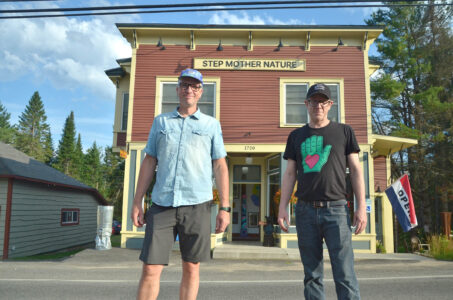Bug death buzz
Paul Smith’s prof writes that pesticides could be killing insects
- Paul Smith’s College Professor Curt Stager is concerned about studies that show flying insects, like this dragonfly in New York City’s Central Park, are experiencing dramatic population losses in Germany. (Photo provided — Curt Stager)
- Mosquitos are one of the types of flying insect included in a German study showing that insect biomass decreased by 80 percent over the period of three decades. (Enterprise photo — Aaron Cerbone)

Paul Smith’s College Professor Curt Stager is concerned about studies that show flying insects, like this dragonfly in New York City’s Central Park, are experiencing dramatic population losses in Germany. (Photo provided — Curt Stager)
PAUL SMITHS — When Paul Smith’s College Professor Curt Stager wrote an op-ed for the New York Times about decreasing bug populations in Germany, he did not expect a massive international response, but that is what he got.
His May 26 essay, titled “The Silence of the Bugs,” is centered around a German study from Radboud University revealing a near 80 percent decline in the total annual weight of flying insects over the past 30 years.
Endangered bee populations hit the news cycle often, Stager said, because they are a commercially valuable insect, but this October 2017 study shows that many other species of insects are dying at an alarming rate.
This was news to a lot of people, and he received hundreds of comments on the Times piece, which hit 200,000 online views and maxed out the comments, as well as dozens of emails from across the country and around the world. Anecdotes from California, Scotland and all over the East Coast backed up Stager’s concern that this was not just a localized event. He says he was surprised at how many people were paying attention to animals usually considered to be pests.
Though insects can be an annoyance to people and a serious threat to farmers, they play a crucial role in every ecosystem as pollinators and a base level of food for countless other species.

Mosquitos are one of the types of flying insect included in a German study showing that insect biomass decreased by 80 percent over the period of three decades. (Enterprise photo — Aaron Cerbone)
Stager said there were several reasons that drove him to write his piece. First was the study itself, which by measuring pounds instead of a single species showed a severe drop-off in vast insects populations across the board.
Second was because the 63 locations across Germany that were analyzed were nature protection areas, not unlike the Adirondack Park. The study determined that the biomass loss was not caused by climate change because the rate of reduction in the bug population did not match up with irregularities in weather data over the same time and occurred rapidly, while global climate change is a slower shift. Deforestation was also ruled out because the areas surveyed were protected areas. This concerned Stager because that meant even protected regions are experiencing dramatic shifts in their ecosystems.
–
Tobacco kills … bugs?
–
With climate change and deforestation ruled out, Stager pins the massive loss of insect populations on pesticides, specifically a new class of pesticides: neonicotinoids, which as the name implies, come from tobacco plants.
Insects that eat food sprayed with “neonics,” as they are called colloquially in the scientific community, become paralyzed and die like they do from any other pesticide, but instead of being a spray that sits on top of the plant and can be washed off, it becomes a part of the plant body.
This turns the plant’s pollen into poison, allowing the deadly chemicals to be carried outside of the field into areas that don’t need pest protection.
–
Silence of the scientists
–
One of the other reasons Stager was compelled to write his article was an equally alarming decline in the population of biologists researching the natural world.
In his article he cites an informal study by the Royal Society for the Protection of Birds, which in 2004 gave motorists a “splatometer” to measure the number of insects hit by cars. The study produced 324,814 “splats,” or an average of one squashed insect every 5 miles.
The study was only performed once, but Stager said he has noticed the same phenomenon in the Adirondacks, anecdotally.
“I remember decades ago I’d drive around in the summer and had to clean my car off every time,” Stager said. “Now I don’t see it. I never have to wash my windshield.”
That is the problem, he said. Most research and evidence of a severe insect decline comes from amateurs, anecdotes and personal memory instead of science.
“Most biologists now don’t do that sort of thing,” Stager said. “They’re all into cells and molecules, biomedical, computer modeling. They’re not out in the woods measuring real, live living things. It’s kind of looked down on in a way.
“If this change has already happened, just trying to do the catch-up work can’t be done. We missed it.”
He said since most scientific centers are in cities, that is where the most funding goes, where it is spent on health or industry. While these are both good causes, he acknowledged, natural studies are typically overlooked.
“It’s just a shame because once you find a problem it’s gotten so big it may be too late to stop,” Stager said. “It made me proud to realize that [Paul Smith’s College is] right at the forefront of this needed focus on natural history and ecology.”
Stager said if the scientific community will not focus on the insect problem, it will take a volunteer effort of gardeners, fly fishers, schools and citizens of all kinds to monitor and track bug populations. He even said the splatometer study was a good example of what can be done.
“We need more of this sort of scientist-directed crowdsourcing,” Stager wrote in his article.
–
Homeowner hazards
–
Stager believes that proper, consistent monitoring of the insect world could have discovered this drop in population and possible link to neonicotinoids earlier, adding that he believes it is an unexpected consequence of the new insecticides.
“It’s not like the chemical companies are evil, trying to destroy the world, but they certainly do want to make a profit,” Stager said.
Neonics are more efficient than their traditional counterparts but have not been researched as long for side effects.
Stager also clarified that while pesticides are necessary for producing the crops that feed us, the problem is misuse of the chemicals. Neonics show up in household brands too, not just industrial-strength pesticides.
“You go to the hardware store and look on the shelf, pesticides, herbicides, right on the label it says, ‘Kill the plants!'” Stager said. “People put them everywhere when they spray it around. They get into the ponds; they get into the neighbor’s yards.”
Tom Tucker of Tucker Farms in Gabriels said the farm he runs with his brother uses low doses of the pesticide Provado to get rid of potato beetles. The farm is licensed for commercial spraying through pesticide classes from Cornell Cooperative Extensions twice a year.
“Farmers tend to use way less [pesticides] than homeowners,” Tucker said. “We’re licensed, and we’re regulated. Every drop of every pound that we buy is accounted for, while a homeowner can go to a store, buy five pounds of it and they can put it on their garden.”
Stager suggested people should “value other kinds of yard instead of a golf course, mono-culture grass.”
Stager will continue to research insect levels in the Adirondacks and encourages anyone else interested in doing so to join groups, talk with experts and become citizen scientists, because they are a dying breed.






